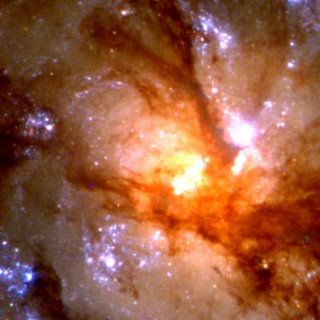Sunday, October 08, 2006
Sapiens on a Sand Particle

The Nobel Foundation announced on October 3 that the 2006 prize for physics will be awarded to Dr. John C. Mather of America's National Aeronautics and Space Administration and Dr. George F. Smoot of the University of California, Berkeley. They discovered irregularities in cosmic microwave radiation that provide actual, if not entirely conclusive, evidence of the Big Bang that occurred billions of years ago. Interestingly, it was a Belgian priest who in 1927 first proposed that the universe started with a big bang – I wonder if Pope Pius XI (1922 – 39) got a bang out of that.
From my perspective, the good thing about this year’s award is that I can grasp what it was for, sort of. These physics prizes seem to go to people at the two extremes of the size spectrum – astrophysicists (Dr. S. Chandrasekhar in 1993) and cosmologists at one and their sub-atomic brethren at the other. I simply cannot comprehend their work. My fundamental problem is with the units they use – trillion trillions or one-trillion-trillionth of something. I know that a trillion trillions is 1,000,000,000,000,000,000,000,000. To me, that’s just a long string of zeroes, with the singular ‘1’ looking like a binomial Pied Piper leading rotund vermin to the river's brink - it doesn’t mean anything.
So, I tried to find something, anything, that would give me a physical appreciation of a trillion trillions. Cellular biologists, who normally don’t care much for math, but win Nobel prizes nevertheless, deal with trillions as well. They estimate that the human body is made of ten trillion human cells and a hundred trillion bacterial cells. Amazing! But, I don’t particularly care to know that I am just a huge collection of bacteria that is willing to accommodate a few human cells (unless I can claim to be a minority human being eligible for reserved privileges). Still, no TT’s here - biologists don’t concern themselves with the sub-atomic particles in cells.
A liter of water weighs one kilogram. The Earth weighs about 6 trillion, trillion kilograms. That helped, a bit, but I needed something that didn’t mix liquids and solids. We went to Morocco a couple of years ago and walked on the dunes of the Sahara desert. Desert sand, unlike beach sand, is totally dry and does not coalesce into clumps. As a result, when a slight breeze blows across the dunes, you can actually see individual particles of sand rolling like tiny marbles atop the lower layers, the effect is quite amazing. That got me wondering about the number of individual particles of sand in the Sahara, or in all the deserts and beaches of the world.
Fortunately for people who are occasionally struck by idle curiosity, as I am, there are others who do something about it - they get to work and fill the internet with delightful trivia. They tell me that the average particle of sand measures 0.5 mm in diameter. This bit of trivia, combined with rigorous estimates of the total area of deserts (beaches can be rounded off) and venturesome assumptions on average desert sand depth, led me to the absurdly precise conclusion that there are 1.80 trillion, trillion individual sand particles in all the deserts and beaches of the world. Voila! I had a physical sense of a TT.
Back to brilliant cosmologists. They have somehow figured out, based partly on measurements of cosmic microwave radiation, that the mass of the observable universe (an unknown fraction of the entire universe) is equal to about that of 25 billion Milky Ways, or 5,020 trillion, trillion times that of our dear Mother Earth. In other words, Mom bears the same relationship to the observable universe as a single particle of sand does to 2,800 times all the deserts and beaches in the world! This is way beyond my reach, all I can do is gape in awe.
On this speck of nothingness reside unknown trillions of beings (mostly under water), some six billion of whom arrogantly call themselves homo sapiens. We can comprehend neither the universe in which we live, nor the universe that lives within each of us. Yet, so many of us firmly believe that we have knowledge of the Creator. This presumed knowledge leads many of us to believe that we are made in the Creator’s image, we are the Creator’s dearest and most precious creation and that the Creator communicates with us through intermediaries, who are eminently human, or even directly. Our belief in such communications is so specific and intense that we are quite willing to harm, or even kill, those whose beliefs differ ever so slightly from ours. Faith is one thing, such intense certainty is quite another.
Homo ferox might be more appropriate.
Subscribe to Posts [Atom]